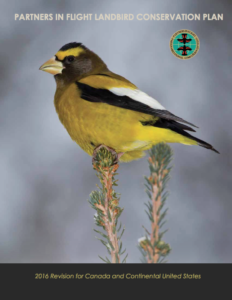
Continued conservation action and investment is needed to help prevent the extinction and endangerment of dozens of landbird species in the U.S. and Canada, according to a new plan by Partners In Flight (PIF). Released last month, the 2016 Landbird Conservation Plan presents new data on the population trends of 448 landbird species in the United States and Canada. The report is an update to PIF’s first 2004 Landbird Conservation Plan and includes new and updated tools that will help guide public, private and community efforts to help species at risk and keep common birds common.
Major findings:
 • Many landbird species continue to exhibit alarming population declines since the last report. The steepest recent declines are seen in grassland birds, species of aridland habitats such as sagebrush and desert scrub, and forest species dependent on specialized structural features or natural disturbance. Desert scrub species of concern in the Sonoran Joint Venture region include Le Conte’s Thrasher and Bendire’s Thrasher.
• Many landbird species continue to exhibit alarming population declines since the last report. The steepest recent declines are seen in grassland birds, species of aridland habitats such as sagebrush and desert scrub, and forest species dependent on specialized structural features or natural disturbance. Desert scrub species of concern in the Sonoran Joint Venture region include Le Conte’s Thrasher and Bendire’s Thrasher.
• Breeding landbird populations have been reduced by over a billion individuals since 1970.
• Among the 86 Watch List species presented in the 2016 Plan revision, 22 species that have already lost at least half of their population in the past 40 years are projected to lose an additional 50% of their current population within the next 40 years. For at least six species, this “half-life” window is fewer than 20 years. In the Sonoran Joint Venture region, Lark Bunting and Loggerhead Shrike are among species with a half-life of less than 10 years.
Plan authors stress the importance of public and private partnerships such as Migratory Bird Joint Ventures to address the challenge of conserving landbird populations. The Plan includes conservation success stories from Joint Ventures across North America, including a profile of SJV’s work in Mexico to empower local communities to improve bird habitats and economies through birding ecotourism.
Download the full Plan here.


 English
English  Español
Español